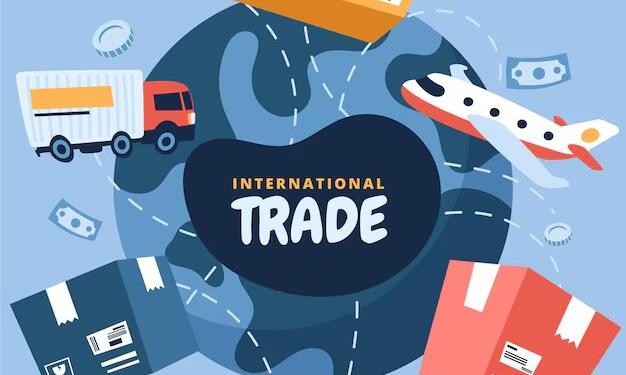Imagine walking into a local store and picking up a Colombian coffee blend, an Italian leather bag, authentic Indian spices or textiles, and Japanese electronics—all under one roof. This seamless access to a world of goods and services has become so common that we rarely stop to consider the invisible connections behind it. These connections are powered by global commerce, a centuries-old practice that continues to evolve and transform economies worldwide. From the food on your plate to the clothes you wear, cross-border exchange plays a pivotal role in shaping the world we live in.
Read this blog to discover how the global exchange of goods and services fuels economic growth, connects cultures, and sparks innovation. We’ll explore its significance, advantages, and impact on businesses and consumers.
What is International Trade?
International trade involves the selling and buying of goods and services across international borders or territories. It includes both exports ( services and goods sold to other countries) and imports ( services and goods purchased from other countries). It’s a crucial aspect of the global economy, promoting economic growth, enhancing consumer choice, and fostering innovation. Trade can take place between individuals, companies, or governments, making it a central component of globalization.
The Evolution of International Trade
The concept of trading across borders dates back to ancient civilizations, with historical trade routes like the Silk Road connecting the East and West.
With the advent of modern shipping, air transport, and digital communication, international trade has become more accessible, allowing even small businesses to participate in global markets. The establishment of trade organizations and agreements, such as the World Trade Organization ( WTO), the North American Free Trade Agreement (i.e., NAFTA), and the European Union (EU), has facilitated easier and more regulated trade across borders.
Benefits of International Trade
There are several advantages of International Trade.
- Economic Growth: By opening up new markets, international trade boosts economic growth for countries involved. It allows businesses to widen their consumer base and diversify revenue streams.
- Consumer Choice and Access to Goods: Trade enables consumers to access a wider variety of services and goods, often at lower prices, due to global competition.
- Specialization and Comparative Advantage: Countries can specialize in producing goods where they have a comparative benefit, leading to more efficient production and better quality products.
- Innovation and Technology Transfer: Exposure to international markets encourages innovation. Countries can also import advanced technology and knowledge, further enhancing their development.
The Role of Trade Agreements and Organizations
- Trade Agreements: Bilateral and multilateral trade agreements are designed to reduce barriers and facilitate smoother trading relationships. Examples are the Comprehensive and Progressive Agreement for Trans-Pacific Partnership (CPTPP) and the African Continental Free Trade Area (AfCFTA).
- Trade Organizations: Organizations like the WTO aim to regulate international trade, resolve disputes, and promote fair practices. They establish rules to ensure trade flows as smoothly and predictably as possible.
- Regional Trade Blocs: The EU and other regional trade blocs create zones where member countries enjoy free or reduced-barrier trade, enhancing economic integration.
Impact on Businesses
- Access to Larger Markets: For businesses, international trade opens access to new markets, allowing them to reach millions of potential customers.
- Increased Competition: While access to larger markets can lead to growth, businesses may also face stiff competition from foreign companies.
- Supply Chain Diversification: International trade enables companies to source materials and components from different regions, reducing reliance on a single market and enhancing supply chain resilience.
- Compliance with International Standards: Companies engaged in international trade need to comply with various regulatory standards, which can vary from one country to another. This often requires adhering to higher quality and safety standards.
Impact on Consumers
- Lower Prices: International competition can drive down prices for customers as companies strive to offer better deals.
- More Choices: Consumers benefit from access to a wider array of products from different countries, including seasonal goods that may not be available locally.
- Quality Improvements: Exposure to global markets encourages manufacturers to improve product quality to compete internationally.
Sustainable Trade Practices
As environmental concerns grow, sustainable trade practices are gaining importance. International trade can have significant environmental impacts due to increased shipping and production. Therefore, efforts are being made to promote eco-friendly production methods, reduce carbon footprints, and encourage fair trade practices.
Future Trends in International Trade
- Digital Trade: The rise of e-commerce has revolutionized international trade, allowing even small businesses to sell products worldwide.
- Focus on Sustainability: Increasing consumer awareness of environmental and social issues will likely push more businesses to adopt sustainable and ethical trading practices.
- Growing Markets: The rise of emerging markets in Asia will create new trade opportunities as the economy continues to develop.
Conclusion
Global trade is a potent driver of economic growth and development, benefiting businesses and consumers around the world. Trade agreements and organizations play a vital role in shaping the global trading landscape, promoting fair competition, and ensuring that trade practices benefit all involved. As businesses and governments continue to adapt to changing global dynamics, the future of international trade promises to be dynamic and full of potential.
It will continue to shape the global economy, providing pathways to growth, innovation, and cultural exchange.































